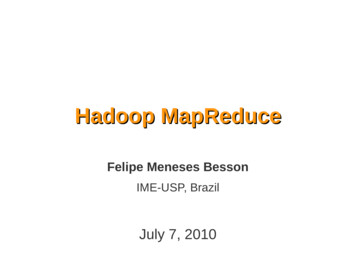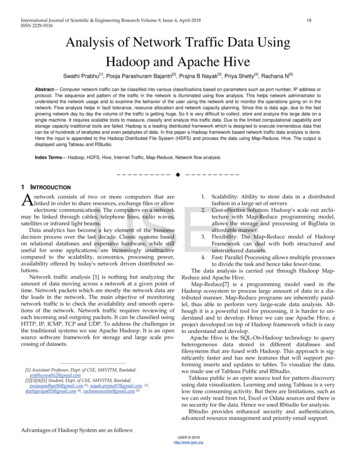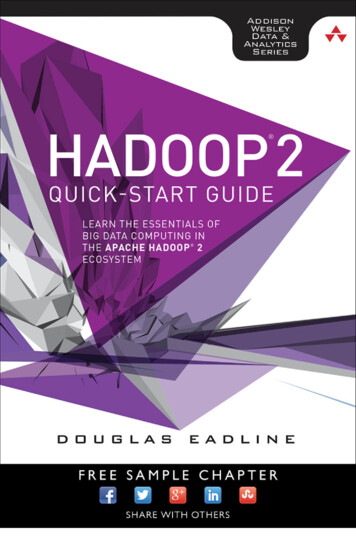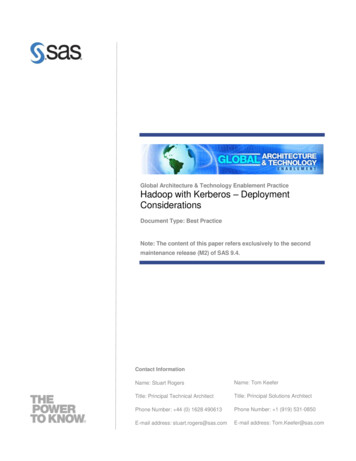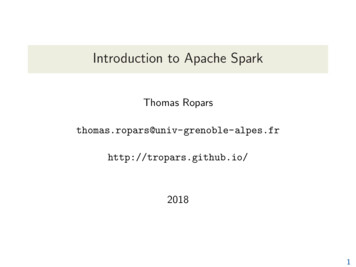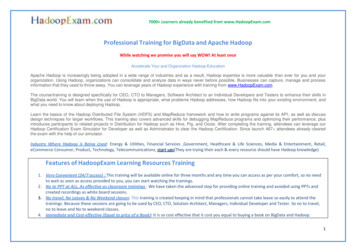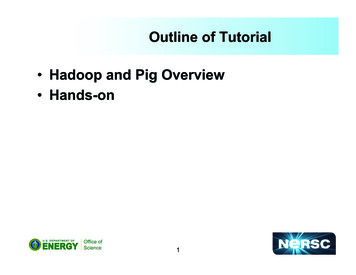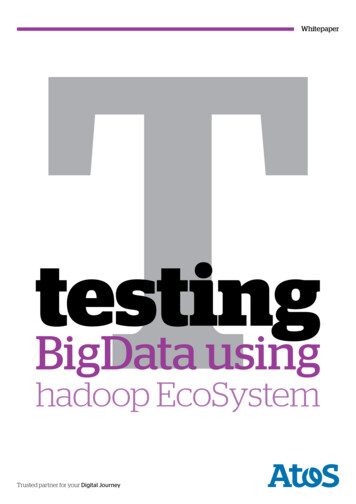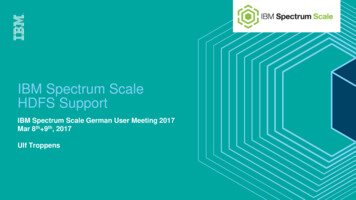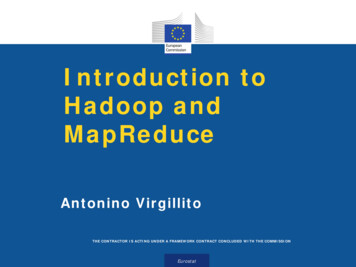
Transcription
Introduction toHadoop andMapReduceAntonino VirgillitoTHE CONTRACTOR IS ACTING UNDER A FRAMEWORK CONTRACT CONCLUDED WITH THE COMMISSIONEurostat
Large-scale Computation Traditional solutions for computing largequantities of data relied mainly on processor Complex processing made on data moved inmemory Scale only by adding power (more memory, fasterprocessor) Works for relatively small-medium amounts ofdata but cannot keep up with larger datasets How to cope with today’s indefinitely growingproduction of data? Terabytes per day2Eurostat
Distributed Computing Multiple machines connected among each otherand cooperating for a common job «Cluster» Challenges Complexity of coordination – all processes anddata have to be maintained syncronized about theglobal system state Failures Data distribution3Eurostat
Hadoop Open source platform for distributed processingof large datasets Based on a project developed at Google Functions: Distribution of data and processing acrossmachines Management of the cluster Simplified programming model Easy to write distributed algorithmsEurostat
Hadoop scalability Hadoop can reach massive scalability byexploiting a simple distribution architecture andcoordination model Huge clusters can be made up using (cheap)commodity hardware A 1000-CPU machine would be much moreexpensive than 1000 single-CPU or 250 quad-coremachines Cluster can easily scale up with little or nomodifications to the programsEurostat
Hadoop Concepts Applications are written in common high-levellanguages Inter-node communication is limited to theminimum Data is distributed in advance Bring the computation close to the data Data is replicated for availability and reliability Scalability and fault-tolerance6Eurostat
Scalability and Fault-tolerance Scalability principle Capacity can be increased by adding nodes to thecluster Increasing load does not cause failures but in theworst case only a graceful degradation ofperformance Fault-tolerance Failure of nodes are considered inevitable and arecoped with in the architecture of the platform System continues to function when failure of a nodeoccurs – tasks are re-scheduled Data replication guarantees no data is lost Dynamic reconfiguration of the cluster when nodesjoin and leaveEurostat7
Benefits of Hadoop Previously impossible or impractical analysismade possible Lower cost Less time Greater flexibility Near-linear scalability Ask Bigger Questions8Eurostat
Hadoop ComponentsHivePigSqoopFlumeMahoutOozieHBaseCore Components9Eurostat
Hadoop Core Components HDFS: Hadoop Distributed File System Abstraction of a file system over a cluster Stores large amount of data by transparentlyspreading it on different machines MapReduce Simple programming model that enables parallelexecution of data processing programs Executes the work on the data near the data In a nutshell: HDFS places the data on the clusterand MapReduce does the processing workEurostat
Structure of an Hadoop Cluster Hadoop Cluster: Group of machines working together to store andprocess data Any number of “worker” nodes Run both HDFS and MapReduce components Two “Master” nodes Name Node: manages HDFS Job Tracker: manages MapReduce11Eurostat
Hadoop PrincipleHadoop is basically amiddleware platform thatmanages a cluster ofmachinesI’m onebig datasetThe core components is adistributed file system(HDFS)Files in HDFS are split intoblocks that are scatteredover the clusterHadoopHDFSThe cluster can growindefinitely simply by addingnew nodesEurostat
The MapReduce ParadigmParallel processing paradigmProgrammer is unaware of parallelismPrograms are structured into a two-phaseexecutionMap Reducex4x5x3Data elements areclassified intocategoriesEurostatAn algorithm is applied to allthe elements of the samecategory
MapReduce and HadoopHadoopMapReduce is logicallyplaced on top of HDFSMapReduceHDFSEurostat
MapReduce and HadoopMR works on (big) filesloaded on HDFSHadoopMRMRMRMRHDFSHDFSHDFSHDFSEach node in the clusterexecutes the MR programin parallel, applying mapand reduces phases on theblocks it storesOutput is writtenon HDFSScalability principle:Perform the computation were the data isEurostat
HDFS Concepts Logical distributed file system that sits on top ofthe native file system of the operating system Written in Java Usable by several languages/tools All common commands for handling operationson a file systems are defined ls, chmod, Commands for moving files from/to the local filesystem are present16Eurostat
Accessing and Storing Files Data files are split into blocks and transparentlydistributed when loaded Each block is replicated in multiple nodes(default:3) NameNode stores metadata “Write-once” file write policy No random writes/updates on files are allowed Optimized for streaming reads of large files Random reads are discouraged/impossible Performs best with large files ( 100Mb)Eurostat17
Accessing HDFS Command line hadoop fs - command Java API Hue Web-based, interactive UI Can browse, upload, download and view files18Eurostat
MapReduce Programming model for parallel execution Programs are realized just by implementing twofunctions Map and Reduce Execution is streamed to the Hadoop cluster andthe functions are processed in parallel on thedata nodes19Eurostat
MapReduce Concepts Automatic parallelization and distribution Fault-tolerance A clean abstraction for programmers MapReduce programs are usually written in Java Can be written in any language using HadoopStreaming All of Hadoop is written in Java MapReduce abstracts all the ‘housekeeping’ awayfrom the developer Developer can simply concentrate on writing theMap and Reduce functionsEurostat20
Programming Model A MapReduce program transforms an input listinto an output list Processing is organized into two steps:map(in key, in value) - (out key, intermediate value) listreduce (out key, intermediate value list) - out value listEurostat
map Data source must be structured in records (lines out offiles, rows of a database, etc) Each record has an associated key Records are fed into the map function as key*value pairs:e.g., (filename, line) map() produces one or more intermediate values alongwith an output key from the input In other words, map identifies input values with the samecharacteristics that are represented by the output key Not necessarily related to input keyEurostat
reduce After the map phase is over, all theintermediate values for a given output keyare combined together into a list reduce() aggregates the intermediatevalues into one or more final values forthat same output key in practice, usually only one final valueper keyEurostat
Example: word countEurostat
Example: word countEurostat
Beyond Word Count Word count is challenging over massive amounts of data Using a single compute node would be too time-consuming Number of unique words can easily exceed availablememory Would need to store to disk Statistics are simple aggregate functions Distributive in nature e.g., max, min, sum, count MapReduce breaks complex tasks down into smallerelements which can be executed in parallel Many common tasks are very similar to word count e.g., log file analysis26Eurostat
MapReduce Applications Text miningIndex buildingGraph creation and analysisPattern recognitionCollaborative filteringPrediction modelsSentiment analysisRisk assessment27Eurostat
Hadoop. Hadoop Principle. I’m one big data set. Hadoop is basically a middleware platform that manages a cluster of machines. The core components is a distributed file system (HDFS) HDFS. Files in HDFS are split into blocks that are scattered over the cluster. The
